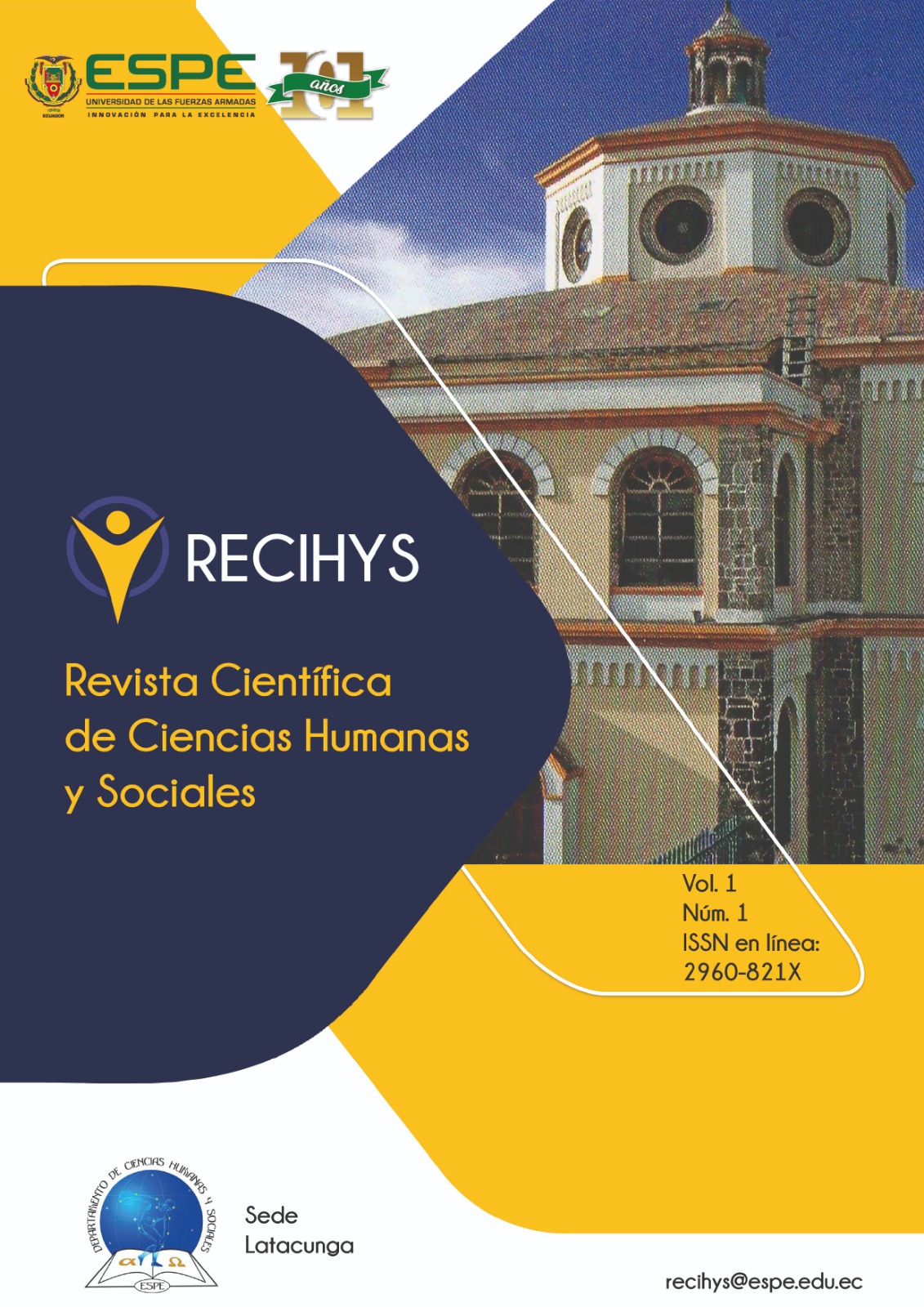La danza folklórica y su aporte en la disminución del sedentarismo en el personal docente
Contenido principal del artículo
Resumen
El personal docente se encuentra atravesando una problemática de salud ocupacional por las largas jornadas de trabajo, queda poco tiempo libre para que pueda desarrollarse; uno de los factores que incide en el sedentarismo de docentes, es la nula práctica de recreación laboral dentro de las instituciones escolares, originada por el desconocimiento de los beneficios que brinda la recreación. Es justo en esta investigación que se hace hincapié sobre la concienciación de los beneficios de la recreación laboral en el personal docente, enfocado desde la parte dancística dentro de la jornada laboral. Ante esta problemática existe una gran cantidad de estudios que explica sobre los beneficios de la recreación laboral como estrategia de la disminución del sedentarismo en docentes del sistema educativo fiscal. Por tal razón el artículo centra su atención en evaluar un programa recreativo de danza folklórica como medio de disminución del sedentarismo dirigido a los docentes de educación media del sistema fiscal. El proyecto se fundamenta en diferentes diseños de investigación, partiendo desde el análisis documental, de campo y cuasi experimental, mediante la aplicación de test dirigidos a los docentes y el sedentarismo que permitieron recolectar datos significativos se alcanzó a determinar el diagnostico; producto de estos análisis investigativos se llegó a formular la conclusión final que da respuesta al objetivo planteado que es disminuir el sedentarismo en docentes. Por lo cual se afirma que el Programa Recreativo de Danza Folklórica tiene efectos significativos en la disminución del sedentarismo en docentes de educación media del sistema fiscal.
##plugins.themes.bootstrap3.displayStats.downloads##
Detalles del artículo

Esta obra está bajo una licencia internacional Creative Commons Atribución-NoComercial-SinDerivadas 4.0.
Los autores que publican en esta revista están de acuerdo con los siguientes términos: Los autores conservan los derechos de autor y garantizan a la revista el derecho de ser la primera publicación del trabajo al igual que licenciado bajo una Creative Commons Attribution License CC BY-NC-ND 4.0 que permite a otros compartir el trabajo con un reconocimiento de la autoría del trabajo y la publicación inicial en esta revista. Los autores pueden establecer por separado acuerdos adicionales para la distribución no exclusiva de la versión de la obra publicada en la revista (por ejemplo, situarlo en un repositorio institucional o publicarlo en un libro), con un reconocimiento de su publicación inicial en esta revista. Se permite y se anima a los autores a difundir sus trabajos electrónicamente (por ejemplo, en repositorios institucionales o en su propio sitio web) antes y durante el proceso de envío, ya que puede dar lugar a intercambios productivos, así como a una citación más temprana y mayor de los trabajos publicados.
Cómo citar
Referencias
Aguilar Chasipanta, W., Bayas Cano, A., Balarezo Mendoza, E., & Galarza, C. (2017). Danza folklórica ecuatoriana: Estudio comparativo para mejorar su enseñanza. Educación Física y Ciencia, 19(1), 027. https://doi.org/10.24215/23142561e027
Aldas, H. (2014). La-Cultura-Fisica-y-su-formacion-profesional-en-la-Republica-del-Ecuador-Physical-Culture-and-his-job-training-in-the-Republic-of-Ecuador-Ambitos-de-la-Cultura-Fisica.pdf. https://www.researchgate.net/profile/Henry_Cayo/publication/329609209_La_Cultura_Fisica_y_su_formacion_profesional_en_la_Republica_del_Ecuador_Physical_Culture_and_his_job_training_in_the_Republic_of_Ecuador_Ambitos_de_la_Cultura_Fisica/links/5c11ec5692851c39ebe92da4/La-Cultura-Fisica-y-su-formacion-profesional-en-la-Republica-del-Ecuador-Physical-Culture-and-his-job-training-in-the-Republic-of-Ecuador-Ambitos-de-la-Cultura-Fisica.pdf
Álvarez Castro, S., & Domínguez Lacayo, M. D. C. (2012). La expresión artística: Otro desafío para la educación rural. Revista Electrónica Educare, 16(3), 115-126. https://doi.org/10.15359/ree.16-3.7
Arias Odón, F. (2012). EL PROYECTO DE INVESTIGACIÓN 6a EDICIÓN. https://www.researchgate.net/publication/301894369_EL_PROYECTO_DE_INVESTIGACION_6a_EDICION
Arias-Gómez, J., Villasís-Keever, M. Á., & Miranda-Novales, M. G. (2016). El protocolo de investigación III: La población de estudio. Revista Alergia México, 63(2), 201. https://doi.org/10.29262/ram.v63i2.181
Asensi-Artiga, V., & Parra-Pujante, A. (2002). El método científico y la nueva filosofía de la ciencia. Anales de Documentación, 5, 9-19.
Baldeón, M., & Ximena, J. (2019). Danza folklórica ecuatoriana y convivencia escolar de las niñas y niños de 3 a 5 años del Centro de Desarrollo Infantil “San Andrés” del Distrito Metropolitano de Quito en el periodo lectivo 2018—2019. http://www.dspace.uce.edu.ec/handle/25000/19624
Castán, Y. (2012). INTRODUCCIÓN AL MÉTODO CIENTÍFICO Y SUS ETAPAS. 6.
Cortés., M., Iglesias, M., & Universidad Autónoma del Carmen (Campeche). (2005). Generalidades sobre metodología de la investigación. Universidad Autónoma del Carmen.
Cortés, Manuel, & Iglesias, M. (2004). Generalidades sobre metodología de la investigación. https://www.rua.unam.mx/portal/recursos/ficha/16760/generalidades-sobre-metodologia-de-la-investigacion
Cossio-Bolaños, M. (2020). Actividad física en tiempos de cuarentena por el COVID-19 en niños y adolescentes. Revista Peruana de ciencia de la actividad fisica y del deporte, 7(2), 2-2.
Cuenca, M. (2019, octubre 21). El ocio como derecho. Manuel Cuenca. https://manuelcuenca.es/el-ocio-como-derecho/
Delgado, Á. A., & Gómez, E. A. (2011). Bases teórico-metodológicas para el estudio semiológico y contextual de la danza folclórica. Gazeta de Antropología, 27(2). http://www.gazeta-antropologia.es/?p=1418
Díez-Palomar, J., & García, R. F. (2010). Comunidades de Aprendizaje: Un proyecto de transformación social y educativa. 13.
Galvan, M. (2015). ¿QUE ES CALIDAD DE VIDA? https://www.uaeh.edu.mx/scige/boletin/prepa2/n2/m2.html
Gerlero, J. C. (2011). La Recreación como derecho constitucional en América Latina. Un estudio para reflexionar sobre el alcance de la recreación en Latinoamérica. 16.
Guerrero, F. (16d. C.). «Fitness Folklore»: La entretenida forma de buscar la salud, el movimiento y la cultura—Salud y Bienestar—24horas. https://www.24horas.cl/tendencias/salud-bienestar/fitness-folklore-la-entretenida-forma-de-buscar-la-salud-el-movimiento-y-la-cultura-2109844
Heras, A., Carrión, T., Largo, N., García, D., Flores, E., Bautista, D., Guzñay, X., Ávila, F., & Cárdenas, D. (2019). Con la danza folklórica se forma disciplina y se fortalece nuestra identidad. http://repositorio.unae.edu.ec/handle/56000/1258
Hidalgo, I. I. V. (2005). Tipos de estudio y métodos de investigación. 12.
ICIM. (2020, abril 13). Cuarentena: Origen del concepto, qué significa y cuál es su implicancia como medida sanitaria. Instituto de Ciencias e Innovación en Medicina. https://medicina.udd.cl/icim/2020/04/13/cuarentena-origen-del-concepto-que-significa-y-cual-es-su-implicancia-como-medida-sanitaria/
Izurieta-Monar, A. (2019). Causas y consecuencias del sedentarismo: Más Vita, 1(2), 26-31.
Jesús, G. (2015). La Recreación y su Valor Educativo. http://jesusgerardosoto.blogspot.com/2015/07/recreacion-valor-educativo_12.html
Lopategui, E. (2000). RECREACIÓN © 2000 Edgar Lopategui Corsino. http://www.saludmed.com/Bienestar/Cap6/Recrear.html

